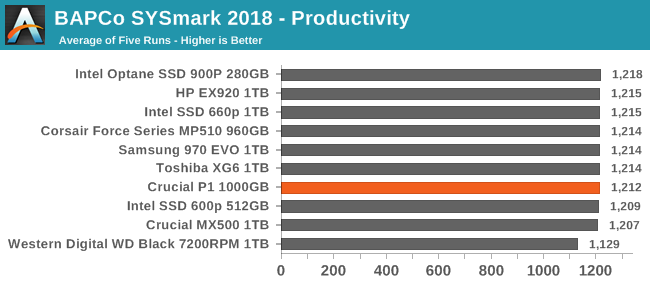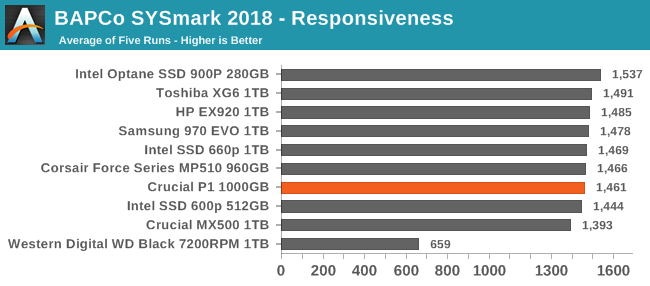The Crucial P1 1TB SSD Review: The Other Consumer QLC SSD
by Billy Tallis on November 8, 2018 9:00 AM ESTBAPCo SYSmark 2018
BAPCo's SYSmark 2018 is an application-based benchmark that uses real-world applications to replay usage patterns of business users, with subscores for productivity, creativity and responsiveness. Scores represnt overall system performance and are calibrated against a reference system that is defined to score 1000 in each of the scenarios. A score of, say, 2000, would imply that the system under test is twice as fast as the reference system.
SYSmark scores are based on total application response time as seen by the user, including not only storage latency but time spent by the processor. This means there's a limit to how much a storage improvement could possibly increase scores, because the SSD is only in use for a small fraction of the total test duration. This is a significant difference from our ATSB tests where only the storage portion of the workload is replicated and disk idle times are cut short to a maximum of 25ms.
| AnandTech SYSmark SSD Testbed | |
| CPU | Intel Core i5-7400 |
| Motherboard | ASUS PRIME Z270-A |
| Chipset | Intel Z270 |
| Memory | 2x 8GB Corsair Vengeance DDR4-2400 CL17 |
| Case | In Win C583 |
| Power Supply | Cooler Master G550M |
| OS | Windows 10 64-bit, version 1803 |
Our SSD testing with SYSmark uses a different test system than the rest of our SSD tests. This machine is set up to measure total system power consumption rather than just the drive's power. The test is run five times in a row on each hardware configuration, and the average scores are reported below.



The creativity and productivity scenarios are relatively unaffected by storage performance, and depend much more on compute power. The responsiveness scores are more dependent on storage performance, but even so the differences between SSDs are fairly small. The Crucial P1 is outperforms the MX500 SATA drive but is a bit slower than the high-end NVMe drives.
Energy Usage
The SYSmark energy usage scores measure total system power consumption, excluding the display. Our SYSmark test system idles at around 26 W and peaks at over 60 W measured at the wall during the benchmark run. SATA SSDs seldom exceed 5 W and idle at a fraction of a watt, and the SSDs spend most of the test idle. This means the energy usage scores will inevitably be very close. A typical notebook system will tend to be better optimized for power efficiency than this desktop system, so the SSD would account for a much larger portion of the total and the score difference between SSDs would be more noticeable.

The energy consumption scores for the SSDs reflect the general trend that higher performance comes with the cost of worse power efficiency. SATA SSDs still lead the rankings for most efficient drive, and the hard drive that's included for comparison purposes required more energy than even the power-hungry Intel Optane SSD 900P.










66 Comments
View All Comments
Billy Tallis - Thursday, November 8, 2018 - link
I think you were looking at the price for the 1TB 970 EVO. The 1TB 970 PRO is currently $392.99 on Amazon, closer to twice the price of the Crucial P1. I think it is occasionally reasonable to get something like the 970 EVO for a high-end system. Going past that to a 970 PRO isn't reasonable.PeachNCream - Thursday, November 8, 2018 - link
Whoops, you're correct! Please accept my apologies for that one.DigitalFreak - Friday, November 9, 2018 - link
Even then, the 970 EVO wipes the floor with the P1.Death666Angel - Thursday, November 8, 2018 - link
Who wants QLC NVME drives as the first widely available consumer QLC tech? Not me I tell you! :DI am fine with 3D TLC for my performance needs both from a performance and price point at the moment. 500GB is enough for many casual enthusiasts and 1TB isn't too expensive either. I'd really like 2.5" SATA and M.2 SATA QLC for my casual media storage needs.
Lolimaster - Friday, November 9, 2018 - link
QLC is such useless product except for manufactures, they give you a WORST product for basically the same price or more than a TLC.MX500/860 EVO 1TB for $160-180.
Lolimaster - Friday, November 9, 2018 - link
*Edit 155-160.piroroadkill - Friday, November 9, 2018 - link
QLC doesn't seem to make any sense in an M.2 PCIe NVMe format - it's just really slow compared to even a good SATA 6Gbps SSD. QLC seems to make sense in a 2.5" SATA format, with an enormous capacity. 1TB makes no sense for this shitty performance level. It needs to be there to replace larger drives. Actually, even that makes no sense for a home user - where long term retention is more important, and a hard disk is therefore more useful. QLC drives will probably come into their own at the ~4TB mark in Enterprise storage arrays as a mid-tier storage solution, with hard disks under, and MLC NAND above.crotach - Friday, November 9, 2018 - link
Oh dearThe_Assimilator - Friday, November 9, 2018 - link
Why the bloody bejesus do these manufacturers keep tying ever-slower NAND to ever-faster interfaces? If you want your bloody QLC NAND to be a success, Crucial, make a 2TB+ SATA SSD that costs less per gigabyte than any other SSD on the market, and watch them fly off the shelves. You already got this right with the Micron 1100 series that uses 3D TLC NAND, why can't you do it for QLC?The_Assimilator - Friday, November 9, 2018 - link
Ah, I see that Micron is touting their "5210 ION" series SSDs (using 3D QLC NAND) as "hard drive replacements", and they start at 2TB. Write speeds are not great, but I don't care and I doubt most consumers looking for high-capacity SSDs will either. Hopefully there will be stock of these in time for Black Friday!